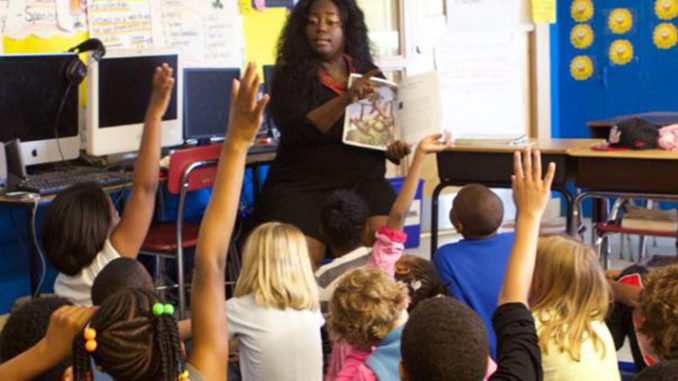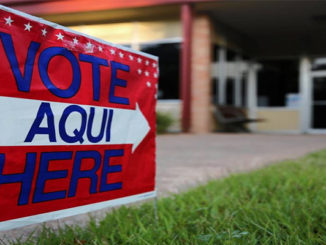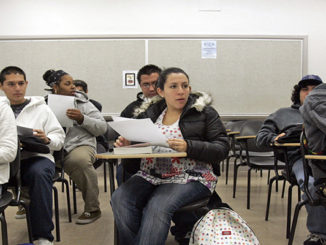
Texas Tribune
At the same time, hundreds of high-poverty schools received A grades, including many in South Texas. Those are just some of the takeaways from this year’s ratings.
Many Texas educators and advocates are frustrated in the week after the state released letter grades rating their school districts and campuses, as they work to decipher the potential impacts for their schools.
Though many school superintendents agree the grades are inaccurate measures of school performance, they still feel pressure to get high marks or else risk receiving harsh state penalties, including the forced closure of a low-performing school. A lot of buzz surrounds the fate of Houston ISD, the state’s largest district, which might see its elected school board replaced with a state-appointed board of managers because of one high school that has failed to meet academic standards for seven years.
Texas released its first official grades for school districts last year, moving away from a pass/fail system. This year, individual campuses began receiving letter grades. State officials argue the letter grades are more transparent for parents who want to understand how a school will educate their children.
But the trends in the data sometimes raise more questions than they answer.
Here are a few takeaways from this year’s ratings:
The majority of Houston ISD’s schools are thriving, but one long-struggling school could result in a state takeover of the district.
The state’s largest school district is at risk of a forced state takeover of its school board, meaning a state-appointed board of managers would make key decisions for Houston ISD’s 279 schools. Wheatley High School, in Houston’s historically black Fifth Ward, received its seventh consecutive low rating from the state. Since 2015, any school that gets five or more consecutive low ratings puts the district at risk for harsh sanctions, at the will of Texas Education Commissioner Mike Morath.
“Every elected official who voted for [House Bill] 1842 —which set mandated sanctions of school closures or state takeover of school boards—should be held accountable for any takeover in HISD based on the failure rating of one school out of 280 campuses,” said Zeph Capo, president of the Texas chapter of the American Federation of Teachers, in a statement last week. “These officials should be stepping up now to stand with us in correcting this mistake.”
Even if Wheatley High School had performed well in this year’s ratings, Houston ISD would still face a potential state takeover due to its dysfunctional school board. Several other school districts, including a few in San Antonio, have been taken over due to persistent school board financial mismanagement and corruption.
A recent preliminary state investigation recommended that state education officials take over Houston ISD’s elected school board, finding that members might have violated state contracting and open meetings laws. Houston ISD is now suing, calling the investigation “one-sided” and saying it was conducted without talking to board members.
Houston ISD isn’t the only district facing state sanctions this year.
The first day of school was no picnic for Eddie Bland, superintendent of Snyder Independent School District in West Texas.
Last Thursday, the same day the doors opened for 2,500 students in four schools, Bland also found out Snyder’s junior high had failed to meet academic standards for the fifth year in a row — meaning the school district will likely be penalized.
“I am heartbroken and was spirit-broken to a certain extent. Then I had to back up and say, ‘We have 600 students showing up to the campus that we have to show up for,'” said Bland, who took over as superintendent last school year. The rural district has struggled to keep teachers from leaving at a rate that had escalated to a high 35% before he arrived, which he said contributed to plummeting student performance.
Snyder ISD, along with Houston ISD and Shepherd ISD, could have its low-performing school forcibly closed or its school board taken over by the state, because of repeated low ratings. Most of Snyder’s students are economically disadvantaged and Hispanic, which Bland argues put the schools at a disadvantage in the ratings.
“I have some concerns about the A-F accountability system personally. I think there are some flaws, some significant biases against poverty and diversity,” he said. “That’s still no excuse for having an F-rated campus.”
Most Ds and Fs went to schools and districts with higher rates of economically disadvantaged students than the state average.
In Texas last school year, 60.6% of students were identified as economically disadvantaged, meaning they qualified for free or reduced-price meals. Of a total of 8,838 schools, 954 with student poverty rates above the state average received Ds or Fs, while just 151 at or below the state average scored that low. The same trend was true for school districts.
Schools with very low poverty rates often performed much better. Just one with a poverty rate at or below 30% received an F: that was the single-campus charter Legacy School of Sport Sciences, outside of Houston, which focuses on the athletics profession. Just 29% of its students are economically disadvantaged.
Many educators refer to this trend to point out the flaws with the state accountability system: It’s much less likely that a school will perform poorly if its students come from higher-income families. The majority of a school’s rating is based on state standardized test scores, and low-income students tend to perform lower on those tests.
South Texas school districts performed even better than last year, despite high rates of student poverty.
No school district in the state’s South Texas region, which includes the Rio Grande Valley, received a score lower than a B, despite rates of economically disadvantaged students far higher than the state average. That region performed even better than last year. Texas divides its school districts into 20 geographical regions.
Of the districts in that region, Valley View ISD, on the border with Mexico, was the traditional school district with the highest poverty rate — 91.9% — to also receive an A from the state. Its superintendent last year touted the district’s free meals and medical care for families who cannot otherwise afford them.
Across the state, 22 school districts and 296 schools with poverty rates at 80% or higher received As. State education officials have said this is proof that “demographics do not equal destiny” and that the system makes it possible for high-poverty schools to succeed.
Aliyya Swaby started as the public education reporter in October 2016. She came to the Tribune from the hyperlocal nonprofit New Haven Independent, where she covered education, zoning and transit for two years. See full Bio
Mandi Cai tells stories with code and graphics as part of the data visuals team. Previously, she created dashboards for scientists at BioBright, a Boston-based biotechnology company, and visualized defense data for Defense Footprint, a project contextualizing the U.S.’s international military presence. See full Bio
This article originally appeared on Texas Tribune with the title Texas schools with more student poverty got the most Ds and Fs in state ratings.



